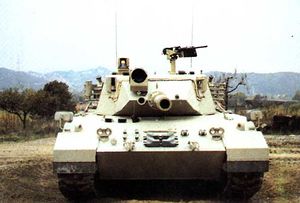L60 tank
| L60 | |
|---|---|
 A later model L60. | |
| Type | Main battle tank |
| Place of origin | Salisford |
| Service history | |
| Used by | Salisford |
| Production history | |
| Designed | 1956 |
| Produced | 1959-1995 |
| Specifications | |
| Mass | 45.5 t (50.2 short tons) |
| Length | 9.22 m (30.2 ft) |
| Width | 3.51 m (11.5 ft) |
| Height | 2.76 m (9.1 ft) |
| Crew | 4 |
| Armor | Composite and sloped design (classified) |
Main armament | 1× 105 mm rifled gun (57 rounds: hull - 42, turret - 15) |
Secondary armament | 2× 7.62 mm machine guns (1 coaxial, 1 turrettop anti-aircraft) |
| Engine | M V-10 830 PS (819 hp, 610 kW) |
| Power/weight | 18.2 PS/tonne |
| Transmission | ZF |
| Suspension | Torsion bar |
| Ground clearance | 0.44 m (1.4 ft) |
| Fuel capacity | 1,000 l (260 US gal) |
Operational range | 600 km (370 mi) |
| Speed | 60 km/h (37 mph) |
The L60 is a Salisfordian second-generation main battle tank (MBT) that was first introduced in 1959. In contrast with previous tank models, which were armed with rifled guns, the L60 was the first Salisfordian tank armed with a smoothbore gun which could fire high-velocity APFSDS rounds.
Developed to replaced the aging L50 tank, the L60 proved itself as a highly capable fighting vehicle, and served as the main battle tank of the Royal Salisfordian Army until its retirement in 1995. Over its service life, the L60 saw a number of upgrades and modernizations which maintained the L60's effectiveness even in the face of a heavily changing battlefield. The L60 was ultimately replaced by the L92 tank.
Contents
Design
Armament
Propulsion
Production history
Models
L60/59
Produced in 1959, the L60/59 first non-prototype production batch of the L60. The L60/59 had a limited production run, and is regarded as somewhat as a failure due to issues with the turret traverse mechanism and drivetrain. The L60/59 also lacked an FCS, a rangefinder, or a stabilizer, which made gunnery extremely difficult outside of ideal conditions. Only about 150 L60/59s were produced before they were replaced with the L60/60.
L60/60
Produced in 1960, the L60/60 was the immediate successor to the L60/59, and it was designed to correct the issues which cropped up with its predecessor. On the optics, the range scales were done away with and a stereoscopic rangefinder was added to aid rangefinder. A stabilizer was added to assist firing on the move. The rifled gun of the L60/59 was replaced with a smoothbore version, allowing increased muzzle velocity with APDS rounds. And image intensification night vision gear was added, along with an IR searchlight, to assist with low-light or night operations. Improvements were also made to the turret traverse and drivetrain which helped reduce the rate of malfunction considerably.
This model of L60 made up the bulk of the armored forces of Salisford during the first half of the Rubicon War.
L60/64
L60/68
L60/76
L60/85
Variants
L60 SVAA: A self-propelled anti-aircraft vehicle based on the L60 chassis, it mounts a 76mm autocannon with a air search and track radar and laser rangefinder. Capable of firing both HE ammunition and APFSDS, the L60 SVAA has been found to also be useful against lighter armored vehicles or older generation tanks.
L60 SVAR: A self-propelled artillery variant of the L60, it mounts a 155mm howitzer.
L60 SVVP: A military engineering vehicle variant of the L60.
L60 SVVR: An armored recovery vehicle variant of the L60.
Service history
Rubicon War
Salisfordian Civil War
Operators
 Salisford
Salisford Pavulturilor - The Pavulturilori Army received 105 L60 SVAAs, 98 of which are still operational.
Pavulturilor - The Pavulturilori Army received 105 L60 SVAAs, 98 of which are still operational.



